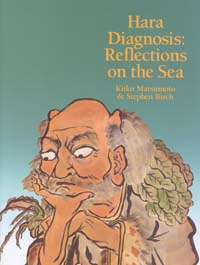Acupuncture and TCM Books
Hara Diagnosis: Reflections on the Sea
 Hara Diagnosis: Reflections on the Sea
Hara Diagnosis: Reflections on the Sea
Check New and Used Prices
by Kiiko Matsumoto, Stephen Birch
Hara Diagnosis presents the theory and practice of abdominal diagnosis with the greatest care ever applied to an important diagnostic technique. Beginning with a historical and cultural perspective on the use of palpation in general, and abdominal palpation in particular, the book details the information required to master and extend the techniques presented. Included are important descriptions of the role of emotional, mental, and spiritual aspects of Chinese medicine. Detailed etymologies, descriptions of historical context, and quotations from classical sources are used to provide a range of insights into hun, po, zhi, jing, and shen, as well as many other seminal concepts.
This text offers an exceptionally well detailed exploration of interior meridian pathways and the role of classical Chinese energetic anatomy, including concepts such as source and origin of qi. The chapters on the dynamics of the triple warmers and the scientific exploration of the qi paradigm are widely regarded as having set a new standard for the relationship of traditional Oriental concepts and Western research.
However, Hara Diagnosis is also an extremely practical text. There are detailed, step-by-step procedures for practical diagnosis and therapy, all of which are accompanied by useful illustrations and case histories. The treatment systems described are coordinated through the abdominal patterns and are staged from the general to the specific. These include hara shiatsu, sotai and breathing exercises, and five-phase treatments. Clear instructions are provided for using Manakas ion pumping cords, mu point diagnosis, O-ring diagnosis, and secondary diagnostic and treatment strategies such as palm diagnosis.
Hara Diagnosis provides not only useful therapeutic and diagnostic information, clinical and theoretical insights, but a general approach to the understanding of acupuncture that draws East and West ever closer.
Author Commentary
This is a quite unique book in the field. The title does not capture the breadth of information covered in this text. The authors not only compiled historical and modern uses of hara diagnosis (abdominal palpation) in the field of East Asian medicine, but also attempted a compilation of historical and modern literatures in an effort to explain how and why Japanese practitioners have placed such a strong emphasis on hara diagnosis. After introducing the historical literature, the text examines the several important concepts and models that are found in the early literature. In particular the internal pathways of the extraordinary vessels are discussed in detail. Mental and emotional correspondences and concepts in East Asian medicine are also discussed. The source theories of the Ling Shu and especially the Nan Jing are described in some detail. The concepts of the moving qi between the kidneys and the triple burner are described at great length, and in more detail than in most other books. Historical ideas about the anatomical basis of the triple burner and the channel systems, and speculations about the embryological development of these systems are also described. Modern anatomical correlates are postulated, examining the possible anatomical basis of the channel systems, extraordinary vessels, triple burner and moving qi between the kidneys, including detailed discussions about possible embryological correlations. Although speculative in nature, these discussions compile a wide and very interesting variety of theories that can extend our understanding of acupuncture.
The clinical chapters of the text describe basic methods of examining the hara, the various palpatory findings and their general interpretations. This is followed by a large chapter on abdominal shiatsu, and a compilation of traditional Japanese massage methods. The use of hara diagnosis in meridian therapy and especially in the work of Dr. Yoshio Manaka are detailed. The last two chapters extend Manaka's ideas compiling a variety of clinically useful ideas and methods including the system of open points. These chapters on the work of Manaka serve as a good introduction to the use of ion-pumping cords, and Manaka's general treatment approach.
Presenting symptoms can be important and useful in diagnosis; they can also be irrelevant and misleading. Trust palpation.
—Yoshio Manaka, MD
It tackles many difficult concepts such as the spiritual, mental and emotional aspects of Chinese medicine, source theory and classical energetic anatomy and physiology. It is a book you can dip into at any time and come out with gems of insight that can only reinforce your belief in a paradigm that is just starting to be explored by our culture and our scientific community.
—Christopher Zaslawski, Australian Journal of T.C.M.
Table Of Contents
Chapter One: The Hara
Chapter Two: Palpation
Chapter Three: Spiritual, Mental, and Emotional
Chapter Four: Internal Trajectories of the Twelve Meridians
Chapter Five: Origins and Energetics
Chapter Six: Source Theory
Chapter Seven: Classical Energetic
Chapter Eight: Modem Anatomy and Physiology
Chapter Nine: Science Revisited
Chapter Ten: Integration and Differentiation:
Chapter Eleven: Hara Diagnosis in Practice
Chapter Twelve: Hara Shiatsu
Chapter Thirteen: Anpuku: Japanese Anma Massage
Chapter Fourteen: Exercises to Strengthen
Chapter Fifteen: Nan Jing Five Phases
Chapter Sixteen: Manaka´s Uses of the Extraordinary Vessels
Chapter Seventeen: Secondary Treatment Strategies
Chapter Eighteen: Manaka´s Biorhythmic Treatments

Hara Diagnosis: Reflections on the Sea
Check New and Used Prices